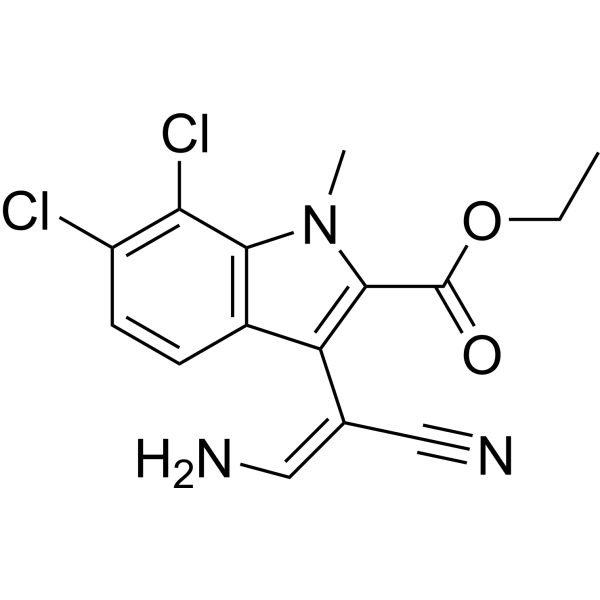Physicochemical Properties
| Molecular Formula | C15H13CL2N3O2 |
| Molecular Weight | 338.19 |
| Exact Mass | 337.038 |
| CAS # | 1354448-60-4 |
| Related CAS # | KH-CB19;1354037-26-5 |
| PubChem CID | 44237094 |
| Appearance | Off-white to light yellow solid powder |
| LogP | 3.1 |
| Hydrogen Bond Donor Count | 1 |
| Hydrogen Bond Acceptor Count | 4 |
| Rotatable Bond Count | 4 |
| Heavy Atom Count | 22 |
| Complexity | 516 |
| Defined Atom Stereocenter Count | 0 |
| SMILES | N1(C)C2=C(C=CC(Cl)=C2Cl)C(C(C#N)=CN)=C1C(OCC)=O |
| InChi Key | CXJCGSPAPOTTSF-VURMDHGXSA-N |
| InChi Code | InChI=1S/C15H13Cl2N3O2/c1-3-22-15(21)14-11(8(6-18)7-19)9-4-5-10(16)12(17)13(9)20(14)2/h4-6H,3,18H2,1-2H3/b8-6- |
| Chemical Name | ethyl 3-[(E)-2-amino-1-cyanoethenyl]-6,7-dichloro-1-methylindole-2-carboxylate |
| HS Tariff Code | 2934.99.9001 |
| Storage |
Powder-20°C 3 years 4°C 2 years In solvent -80°C 6 months -20°C 1 month |
| Shipping Condition | Room temperature (This product is stable at ambient temperature for a few days during ordinary shipping and time spent in Customs) |
Biological Activity
| Targets | CLK1 16.5 nM (IC50) DYRK1A 57.8 nM (IC50) CLK3 488 nM (IC50) |
| ln Vitro | KH-CB20 is more selective than DYRK1A (IC50=57.8 nM) and CLK3 (IC50=488 nM) for CLK1 (IC50=16.5 nM) [1]. |
| References |
[1]. Specific CLK inhibitors from a novel chemotype for regulation of alternative splicing. Chem Biol. 2011 Jan 28;18(1):67-76. |
Solubility Data
| Solubility (In Vitro) | DMSO : 100 mg/mL (295.69 mM) |
| Solubility (In Vivo) |
Solubility in Formulation 1: ≥ 2.5 mg/mL (7.39 mM) (saturation unknown) in 10% DMSO + 40% PEG300 + 5% Tween80 + 45% Saline (add these co-solvents sequentially from left to right, and one by one), suspension solution. For example, if 1 mL of working solution is to be prepared, you can add 100 μL of 25.0 mg/mL clear DMSO stock solution to 400 μL PEG300 and mix evenly; then add 50 μL Tween-80 to the above solution and mix evenly; then add 450 μL normal saline to adjust the volume to 1 mL. Preparation of saline: Dissolve 0.9 g of sodium chloride in 100 mL ddH₂ O to obtain a clear solution. Solubility in Formulation 2: ≥ 2.5 mg/mL (7.39 mM) (saturation unknown) in 10% DMSO + 90% (20% SBE-β-CD in Saline) (add these co-solvents sequentially from left to right, and one by one), clear solution. For example, if 1 mL of working solution is to be prepared, you can add 100 μL of 25.0 mg/mL clear DMSO stock solution to 900 μL of 20% SBE-β-CD physiological saline solution and mix evenly. Preparation of 20% SBE-β-CD in Saline (4°C,1 week): Dissolve 2 g SBE-β-CD in 10 mL saline to obtain a clear solution. Solubility in Formulation 3: ≥ 2.5 mg/mL (7.39 mM) (saturation unknown) in 10% DMSO + 90% Corn Oil (add these co-solvents sequentially from left to right, and one by one), clear solution. For example, if 1 mL of working solution is to be prepared, you can add 100 μL of 25.0 mg/mL clear DMSO stock solution to 900 μL of corn oil and mix evenly. (Please use freshly prepared in vivo formulations for optimal results.) |
| Preparing Stock Solutions | 1 mg | 5 mg | 10 mg | |
| 1 mM | 2.9569 mL | 14.7846 mL | 29.5692 mL | |
| 5 mM | 0.5914 mL | 2.9569 mL | 5.9138 mL | |
| 10 mM | 0.2957 mL | 1.4785 mL | 2.9569 mL |
